Baseline Calibration Scheme Embedded in Single-Slope ADC for Gas Sensor Applications
Abstract
1. Introduction
2. Characteristics of Baseline Variation
3. Proposed SS ADC with Baseline Calibration Scheme
3.1. Typical SS ADC for Gas Sensor Readout
3.2. Proposed Baseline Calibration Scheme
4. Simulation Results and Discussion
5. Conclusions
Author Contributions
Funding
Data Availability Statement
Conflicts of Interest
References
- Spirjakin, D.; Baranov, A.; Akbari, S. Wearable Wireless Sensor System with RF Remote Activation for Gas Monitoring Applications. IEEE Sens. J. 2018, 18, 2976–2982. [Google Scholar] [CrossRef]
- Kim, J.G.; Bai, B.C. A Chemical Safety Assessment of Lyocell-Based Activated Carbon Fiber with a High Surface Area through the Evaluation of HCl Gas Adsorption and Electrochemical Properties. Separations 2024, 11, 79. [Google Scholar] [CrossRef]
- Christakis, I.; Tsakiridis, O.; Kandris, D.; Stavrakas, I. Air Pollution Monitoring via Wireless Sensor Networks: The Investigation and Correction of the Aging Behavior of Electrochemical Gaseous Pollutant Sensors. Electronics 2023, 12, 1842. [Google Scholar] [CrossRef]
- Neri, G. First Fifty Years of Chemoresistive Gas Sensors. Chemosensors 2015, 3, 1–20. [Google Scholar] [CrossRef]
- Yamazoe, N. Toward innovations of gas sensor technology. Sens. Actuators B Chem. 2005, 108, 2–14. [Google Scholar] [CrossRef]
- Norzam, W.A.S.; Hawari, H.F.; Kamarudin, K.; Juffry, Z.H.M.; Hussein, N.A.A.; Gupta, M.; Abdullah, A.N. Mobile Robot Gas Source Localization Using SLAM-GDM with a Graphene-Based Gas Sensor. Electronics 2023, 12, 171. [Google Scholar] [CrossRef]
- Uma, S.; Shobana, M.K. Metal oxide semiconductor gas sensors in clinical diagnosis and environmental monitoring. Sens. Actuators A Phys. 2023, 349, 114044. [Google Scholar] [CrossRef]
- Nikolic, M.V.; Milovanovic, V.; Vasiljevic, Z.Z.; Stamenkovic, Z. Semiconductor Gas Sensors: Materials, Technology, Design, and Application. Sensors 2020, 20, 6694. [Google Scholar] [CrossRef] [PubMed]
- Krishna, K.G.; Parne, S.; Pothukanuri, N.; Kathirvelu, V.; Gandi, S.; Joshi, D. Nanostructured metal oxide semiconductor-based gas sensors: A comprehensive review. Sens. Actuators A Phys. 2022, 341, 113578. [Google Scholar] [CrossRef]
- Shaposhnik, A.V.; Moskalev, P.V.; Chegereva, K.L.; Zviagin, A.A.; Vasiliev, A.A. Selective gas detection of H2 and CO by a single MOX-sensor. Sens. Actuators B Chem. 2021, 334, 129376. [Google Scholar] [CrossRef]
- Furst, L.; Feliciano, M.; Frare, L.; Igrejas, G. A Portable Device for Methane Measurement Using a Low-Cost Semiconductor Sensor: Development, Calibration and Environmental Applications. Sensors 2021, 21, 7456. [Google Scholar] [CrossRef] [PubMed]
- Kim, J.N.; Kim, H.J. A Chemoresistive Gas Sensor Readout Integrated Circuit with Sensor Offset Cancellation Technique. IEEE Access 2023, 11, 85405–85413. [Google Scholar] [CrossRef]
- Ng, K.T.; Boussaid, F.; Bermak, A. A CMOS Single-Chip Gas Recognition Circuit for Metal Oxide Gas Sensor Arrays. IEEE Trans. Circuits Syst. I Regul. Pap. 2011, 58, 1569–1580. [Google Scholar] [CrossRef]
- Nazemi, H.; Joseph, A.; Park, J.; Emadi, A. Advanced Micro- and Nano-Gas Sensor Technology: A Review. Sensors 2019, 19, 1285. [Google Scholar] [CrossRef] [PubMed]
- Haugen, J.-E.; Tomic, O.; Kvaal, K. A calibration method for handling the temporal drift of solid state gas-sensors. Anal. Chim. Acta 2000, 407, 23–39. [Google Scholar] [CrossRef]
- Grassi, M.; Malcovati, P.; Baschirotto, A. A 141-dB Dynamic Range CMOS Gas-Sensor Interface Circuit Without Calibration With 16-Bit Digital Output Word. IEEE J. Solid-State Circuits 2007, 42, 1543–1554. [Google Scholar] [CrossRef]
- Lee, D.Y.; Yu, J.B.; Byun, H.G.; Kim, H.J. Chemoresistive Sensor Readout Circuit Design for Detecting Gases with Slow Response Time Characteristics. Sensors 2022, 22, 1102. [Google Scholar] [CrossRef] [PubMed]
- Choi, S.; Park, C.S.; Chae, H.Y.; Oh, B.; Lee, J.; Kwon, Y.M.; Baik, J.M.; Shin, H.; Kim, J.J. A Wide Dynamic Range Multi-Sensor ROIC for Portable Environmental Monitoring Systems With Two-Step Self-Optimization Schemes. IEEE Trans. Circuits Syst. I Regul. Pap. 2021, 68, 2432–2443. [Google Scholar] [CrossRef]
- Kim, H.J. 11-bit Column-Parallel Single-Slope ADC With First-Step Half-Reference Ramping Scheme for High-Speed CMOS Image Sensors. IEEE J. Solid-State Circuits 2021, 56, 2132–2141. [Google Scholar] [CrossRef]
- Zhang, H.; Zhang, Z.; Li, Z.; Han, H.; Song, W.; Yi, J. A chemiresistive-potentiometric multivariate sensor for discriminative gas detection. Nat. Commun. 2023, 14, 3495. [Google Scholar] [CrossRef]
- Korotcenkov, G.; Cho, B.K. Instability of metal oxide-based conductometric gas sensors and approaches to stability improvement (short survey). Sens. Actuators B Chem. 2011, 156, 527–538. [Google Scholar] [CrossRef]
- Ciciotti, F.; Buffa, C.; Radogna, A.V.; Francioso, L.; Capone, S.; Gaggl, R.; Baschirotto, A. A 450-µA 128-dB Dynamic Range A/D CMOS Interface for MOX Gas Sensors. IEEE Sens. J. 2019, 19, 12069–12078. [Google Scholar] [CrossRef]
- Boukhayma, A.; Peizerat, A.; Enz, C. A Sub-0.5 Electron Read Noise VGA Image Sensor in a Standard CMOS Process. IEEE J. Solid-State Circuits 2016, 51, 2180–2191. [Google Scholar] [CrossRef]
- Kłosowski, M. A Power-Efficient Digital Technique for Gain and Offset Correction in Slope ADCs. IEEE Trans. Circuits Syst. II Express Briefs 2020, 67, 979–983. [Google Scholar] [CrossRef]
- Park, K.; Yeom, S.; Kim, S.Y. Ultra-Low Power CMOS Image Sensor With Two-Step Logical Shift Algorithm-Based Correlated Double Sampling Scheme. IEEE Trans. Circuits Syst. I Regul. Pap. 2020, 67, 3718–3727. [Google Scholar] [CrossRef]
- An, N.; Li, Y.; Zhang, H.; Liang, Y.; Tan, T.; Guo, Y.; Liu, Z.; Liu, M.; Guo, Y.; Wu, Y.; et al. Brillouin lasers in a graphene microresonator for multispecies and individual gas molecule detection. APL Photonics 2023, 8, 100801. [Google Scholar] [CrossRef]
- Guo, Y.; Li, Z.; An, N.; Guo, Y.; Wang, Y.; Yuan, Y.; Zhang, H.; Tan, T.; Wu, C.; Peng, B.; et al. A Monolithic Graphene-Functionalized Microlaser for Multispecies Gas Detection. Adv. Mater. 2022, 34, 2207777. [Google Scholar] [CrossRef]
- Wang, Y.; Li, Y.; Li, Y.; Zhang, H.; Liu, Z.; Guo, Y.; Wang, Z.; He, J.; Guo, X.; Wang, Y.; et al. Noise canceled graphene-microcavity fiber laser sensor for ultrasensitive gas detection. Photon. Res. 2023, 11, A1–A9. [Google Scholar] [CrossRef]
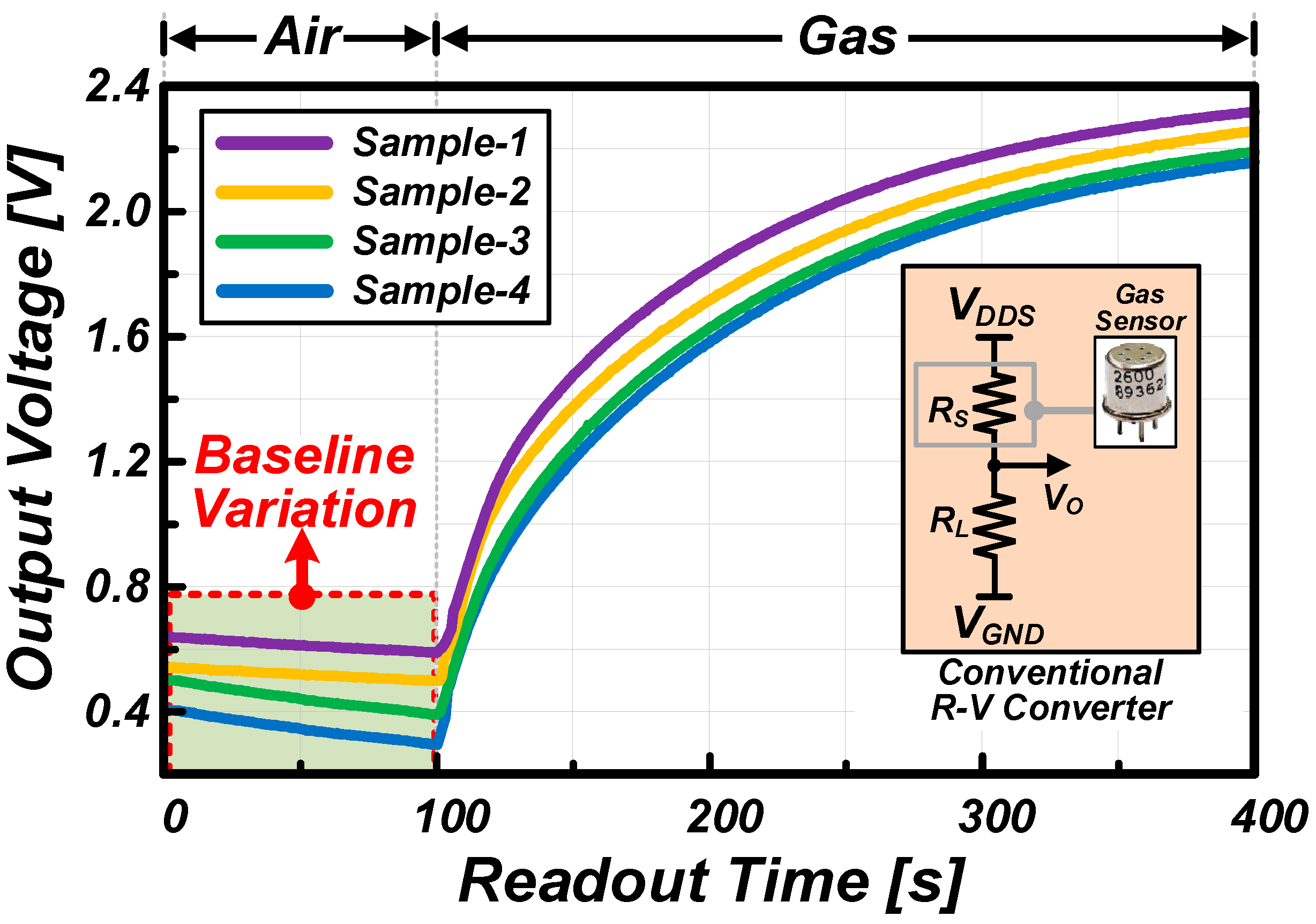
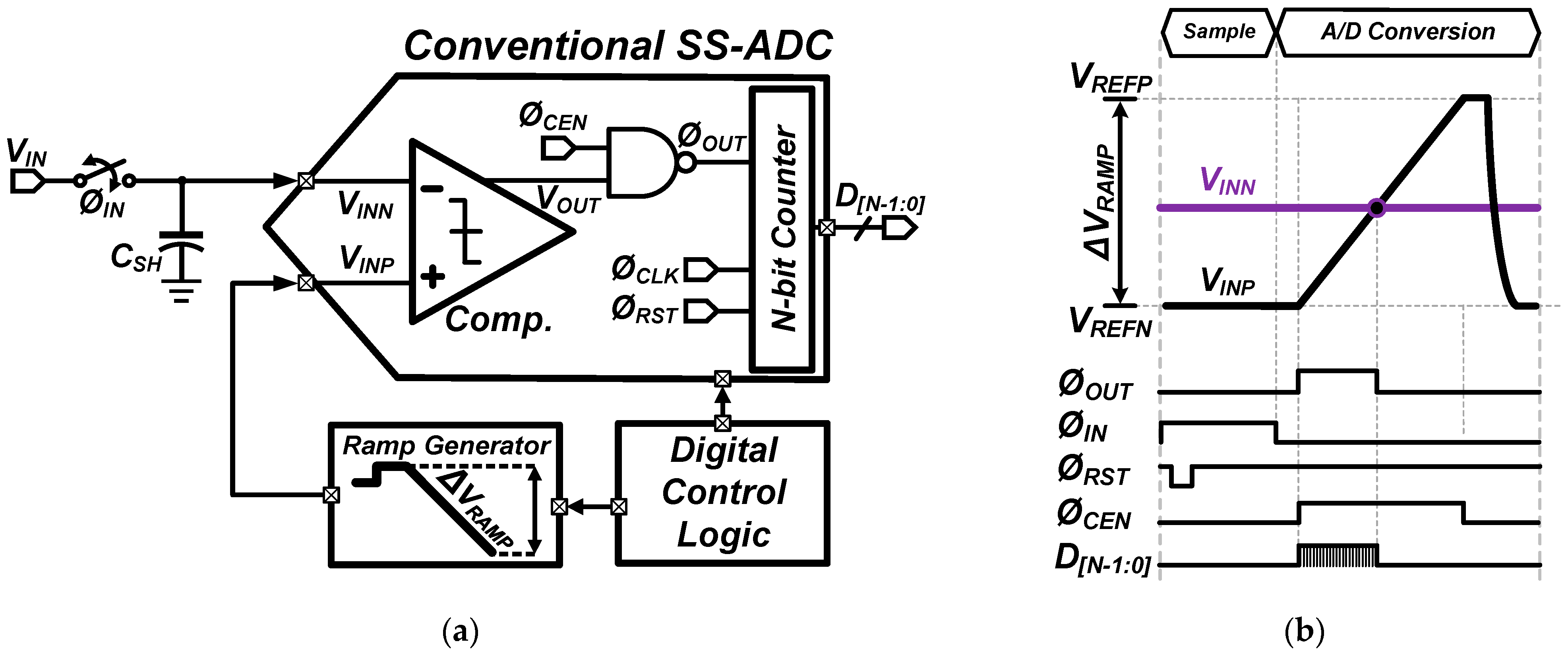
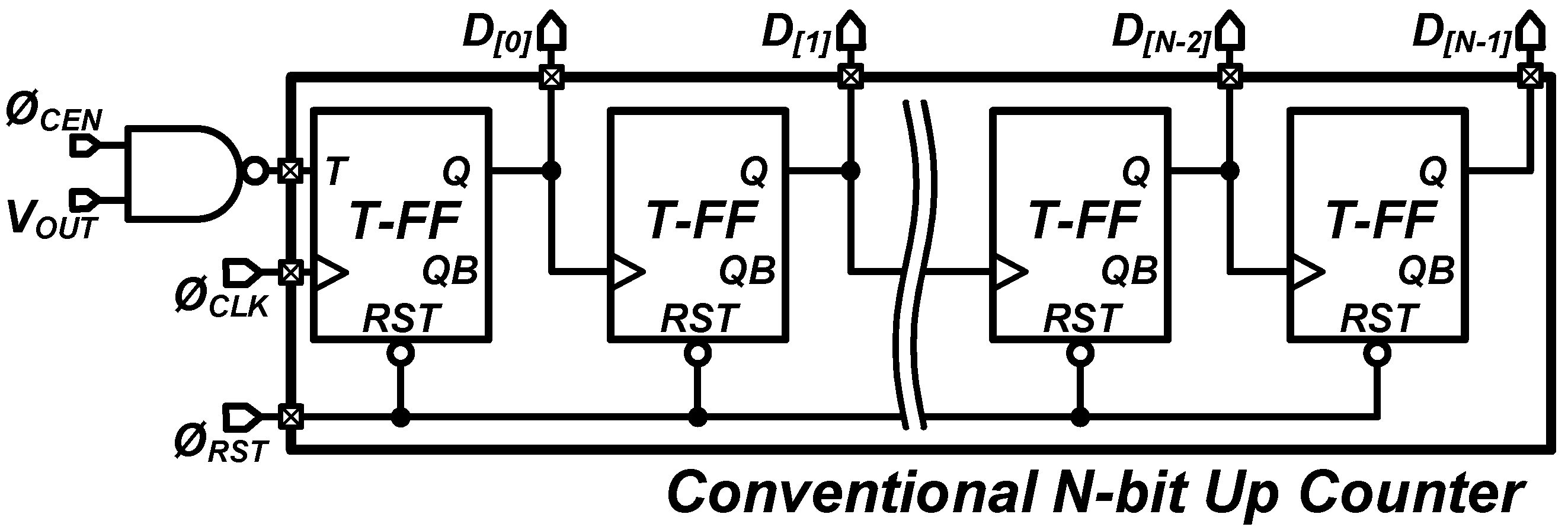
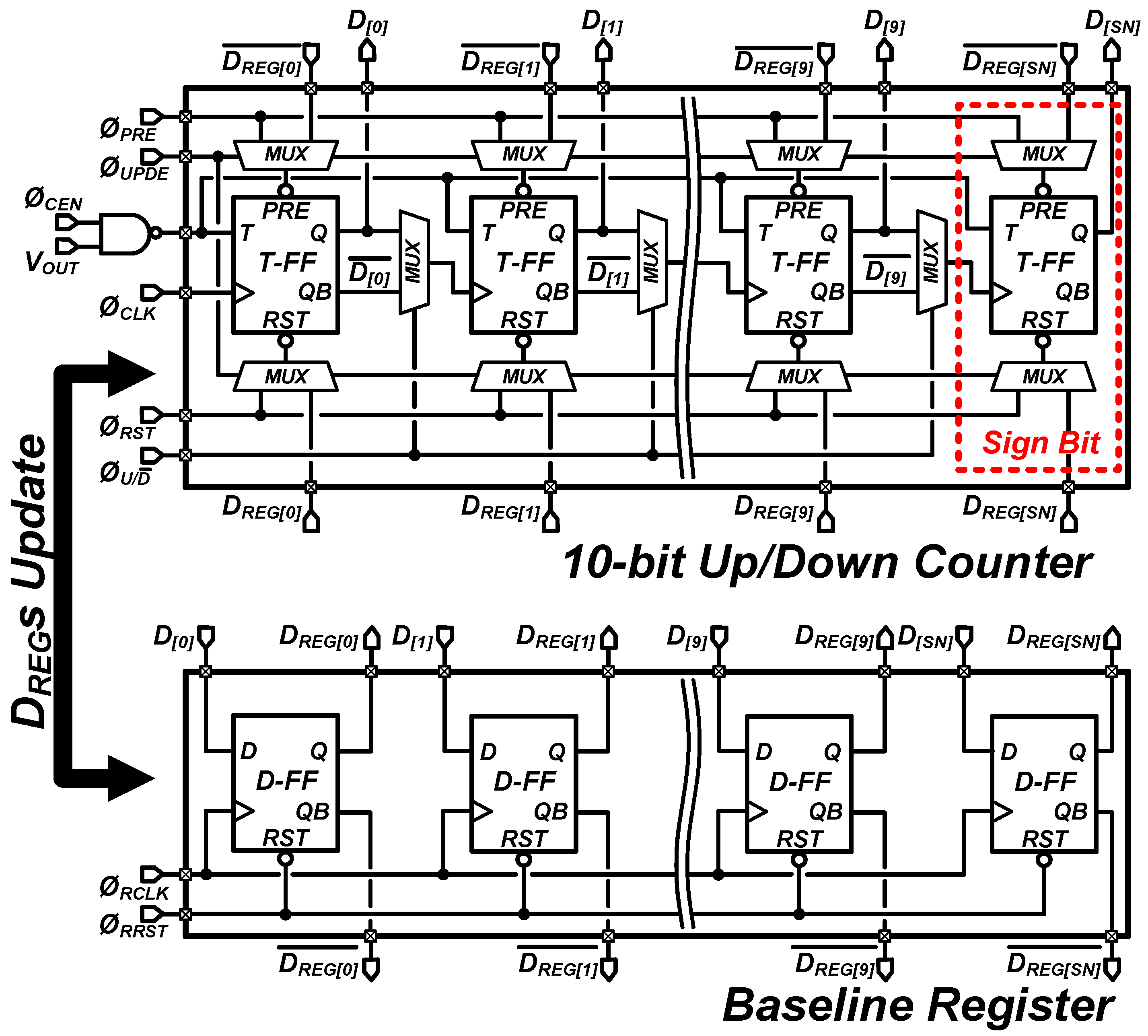

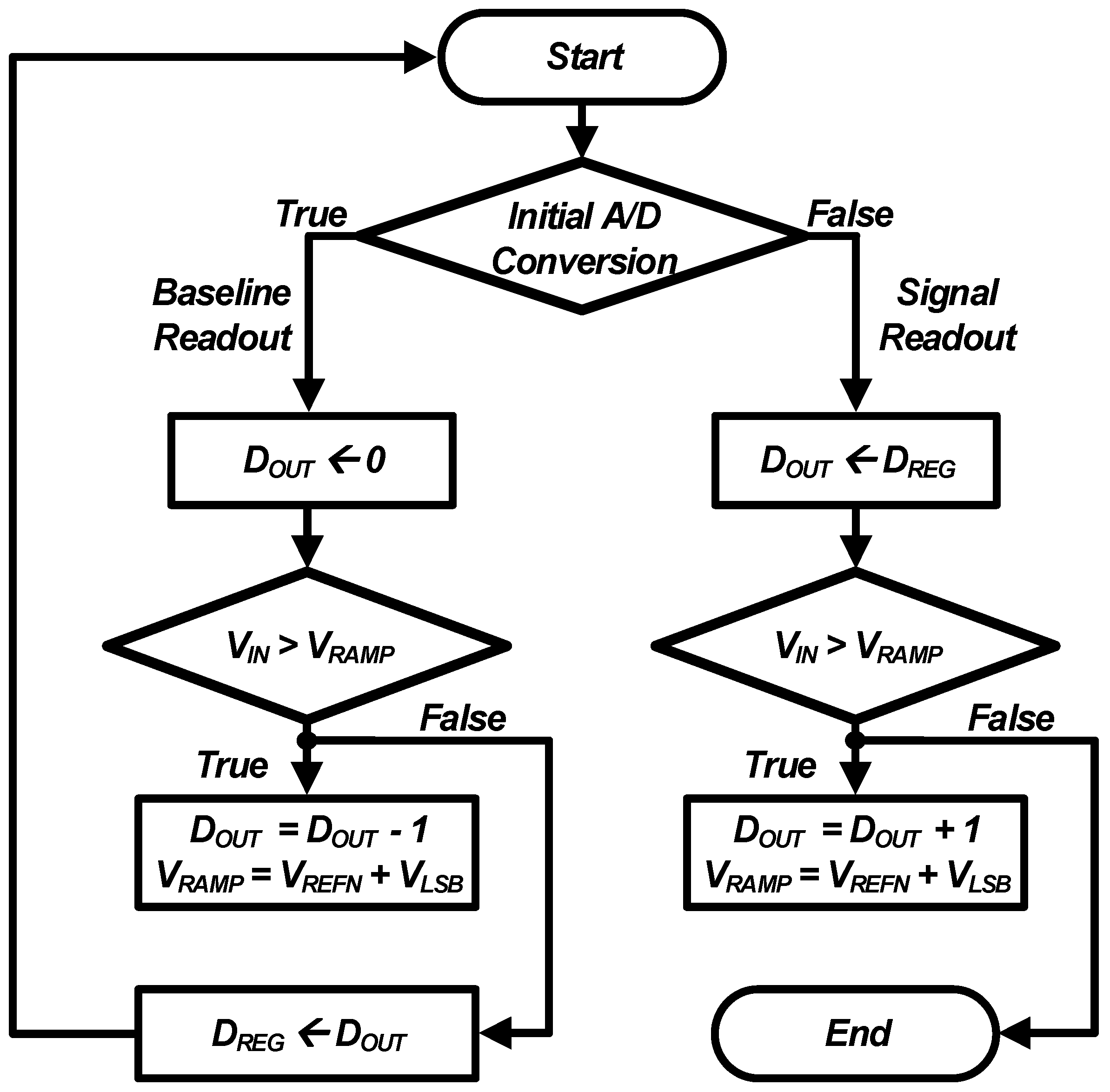
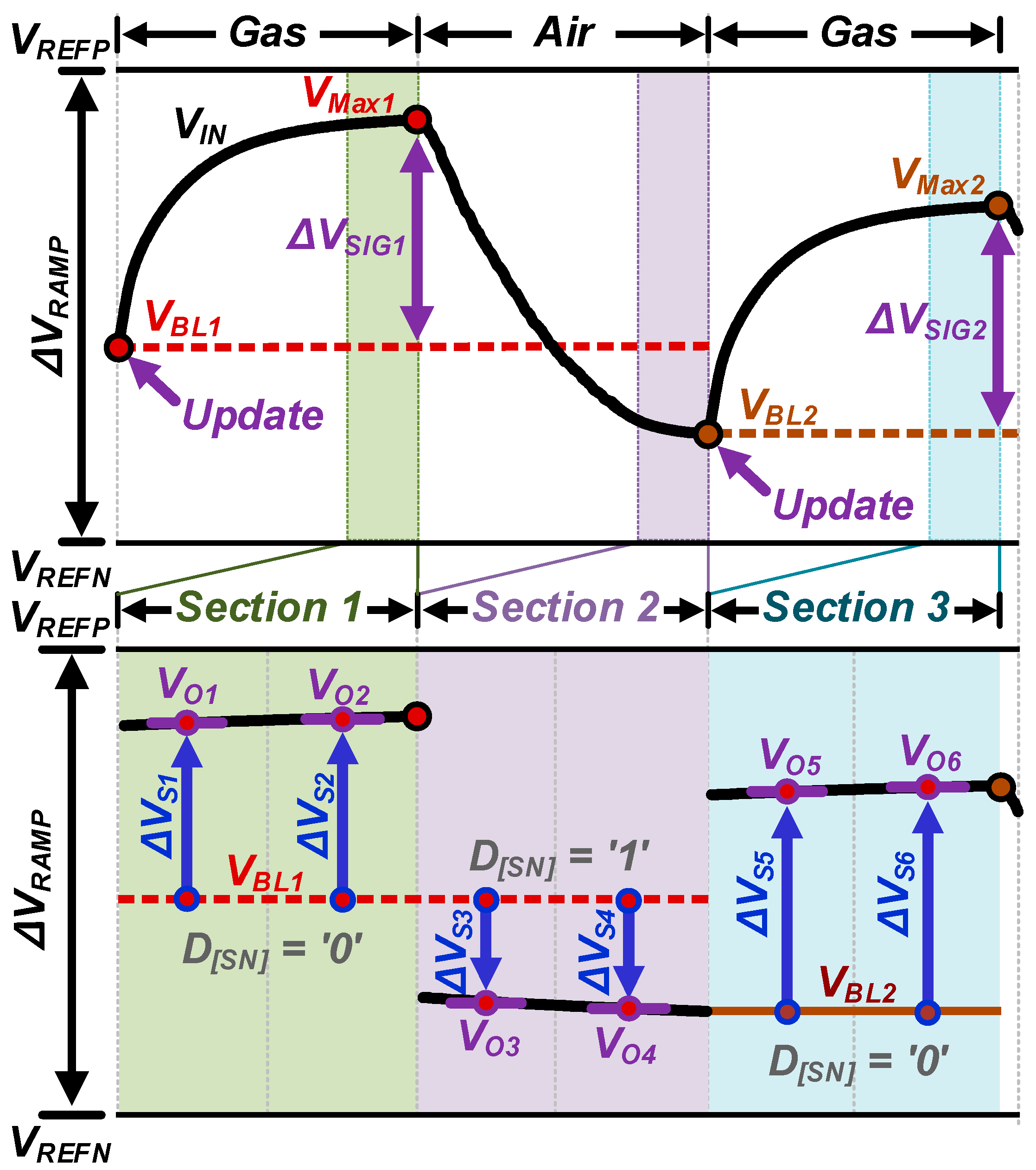

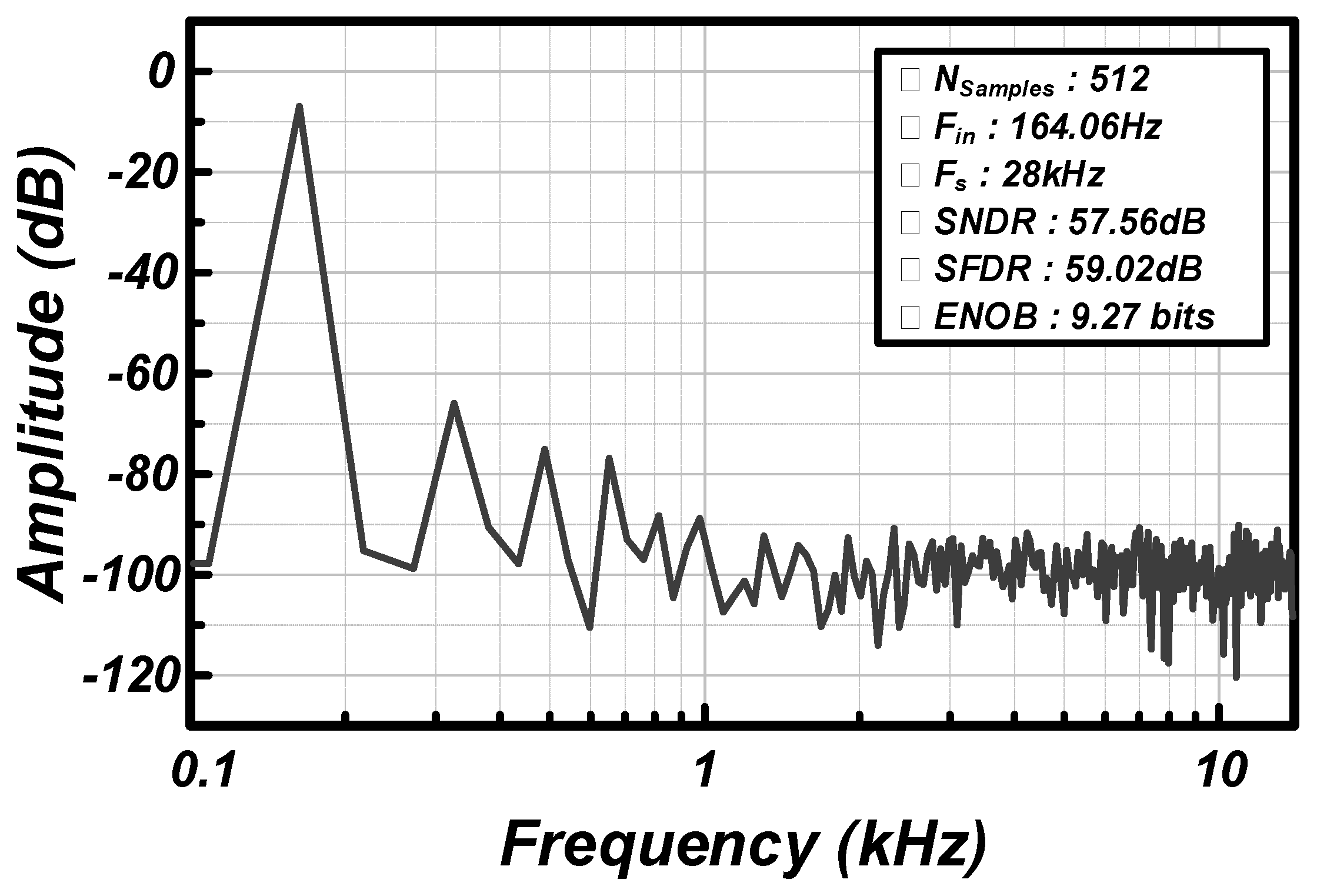

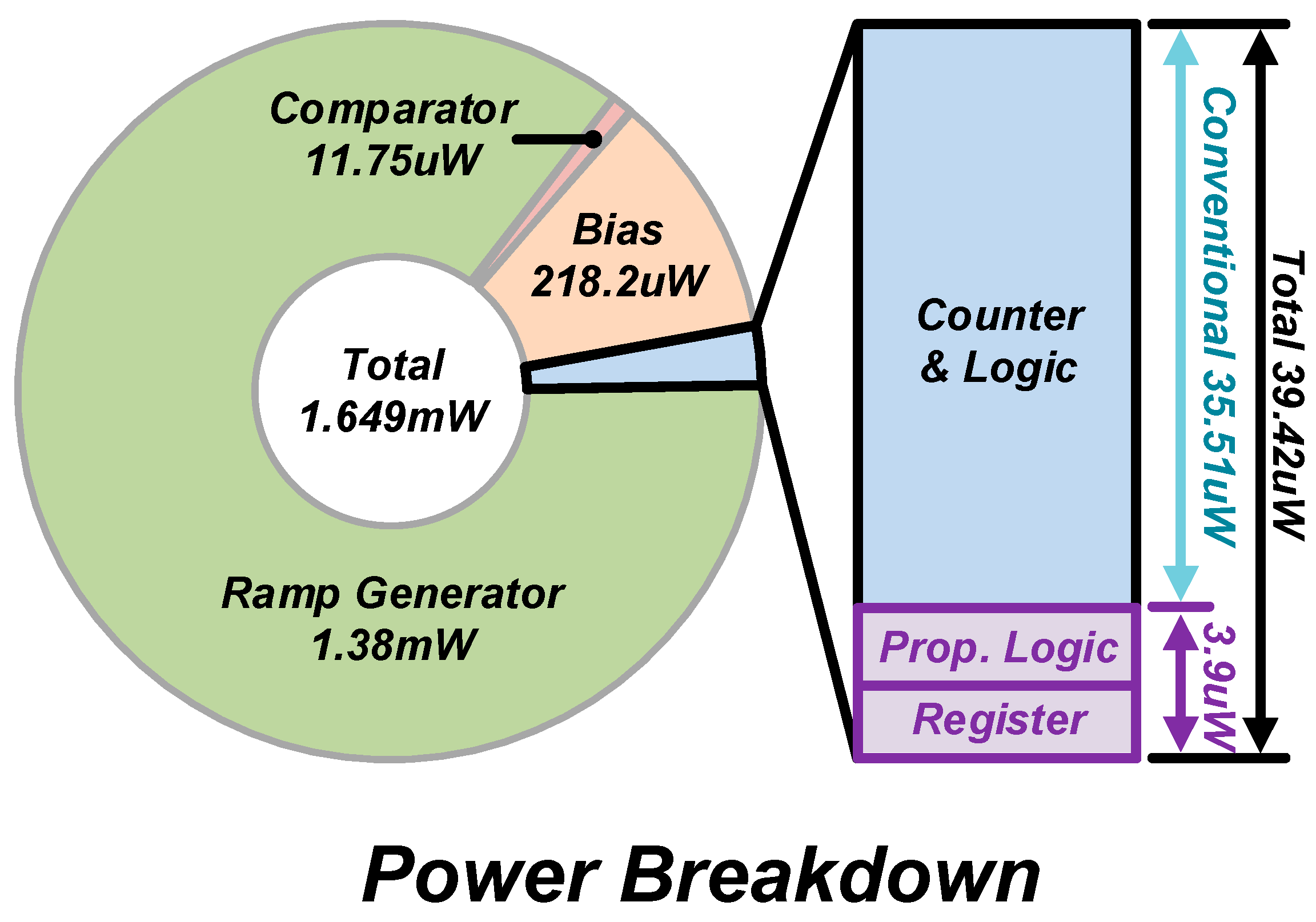
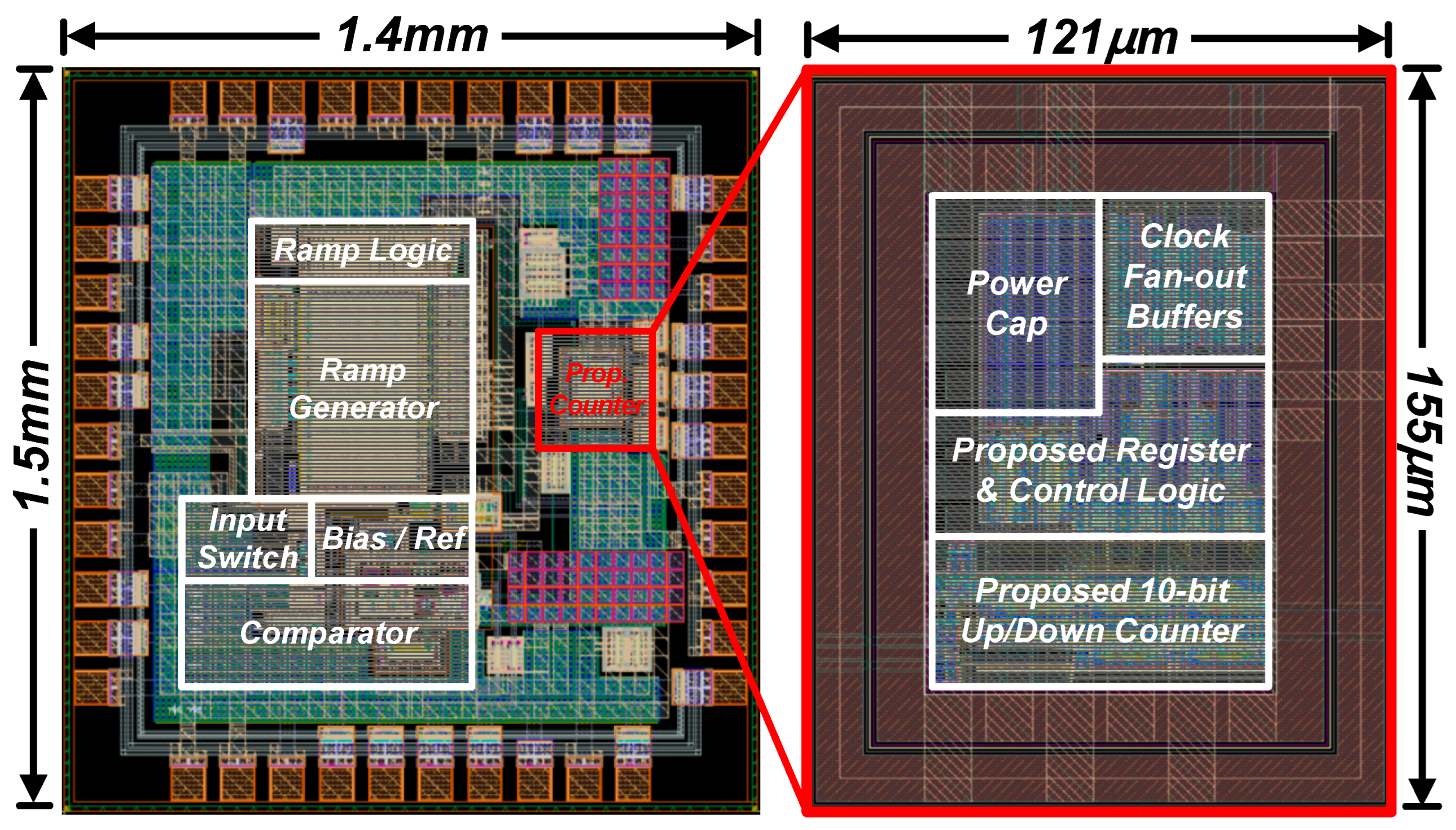
| Parameter | Conventional Counter | Proposed Counter and Register | |
|---|---|---|---|
| Total Number of Transistors | Counter Unit Cell (T-FF) | 420 (×10 units) | 462 (×11 units) |
| Counter Unit Cell (T-FF) | 0 | 308 (×11 units) | |
| MUX Switch | 0 | 434 (×31 units) | |
| Control Logic Gate | 18 | 18 | |
| 438 | 1222 | ||
| Digital Power Consumption | 35.51 μW | 39.42 μW | |
| Area Consumption of Counter | = 0.136 mm2 | = 0.187 mm2 | |
| Unique Function | - | Baseline Digital Calibration | |
| Parameter | Value |
|---|---|
| Technology | 0.18 μm 1P6M CMOS Process |
| Supply Voltages | 2.8 V (Analog), 1.8 V (Digital) |
| ADC Input Range | 1.2 V |
| Power Consumption | 1.649 mW |
| ADC Resolution | 10 bits |
| SNDR | 57.56 dB @Fin = 164.06 Hz |
| ENOB | 9.27 bits @Fin = 164.06 Hz |
| DNL | +0.259/−0.263 |
| INL | +0.868/−0.122 |
| Sampling Rate | 28 kHz |
| Sensing Type | Resistance |
| Sensing Range | 10~120 kΩ |
| Unique Function | Baseline Digital Calibration |
Disclaimer/Publisher’s Note: The statements, opinions and data contained in all publications are solely those of the individual author(s) and contributor(s) and not of MDPI and/or the editor(s). MDPI and/or the editor(s) disclaim responsibility for any injury to people or property resulting from any ideas, methods, instructions or products referred to in the content. |
© 2024 by the authors. Licensee MDPI, Basel, Switzerland. This article is an open access article distributed under the terms and conditions of the Creative Commons Attribution (CC BY) license (https://creativecommons.org/licenses/by/4.0/).
Share and Cite
Hyeon, J.-S.; Kim, H.-J. Baseline Calibration Scheme Embedded in Single-Slope ADC for Gas Sensor Applications. Electronics 2024, 13, 1252. https://doi.org/10.3390/electronics13071252
Hyeon J-S, Kim H-J. Baseline Calibration Scheme Embedded in Single-Slope ADC for Gas Sensor Applications. Electronics. 2024; 13(7):1252. https://doi.org/10.3390/electronics13071252
Chicago/Turabian StyleHyeon, Jang-Su, and Hyeon-June Kim. 2024. "Baseline Calibration Scheme Embedded in Single-Slope ADC for Gas Sensor Applications" Electronics 13, no. 7: 1252. https://doi.org/10.3390/electronics13071252
APA StyleHyeon, J.-S., & Kim, H.-J. (2024). Baseline Calibration Scheme Embedded in Single-Slope ADC for Gas Sensor Applications. Electronics, 13(7), 1252. https://doi.org/10.3390/electronics13071252






